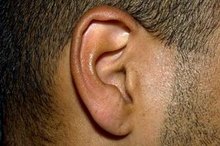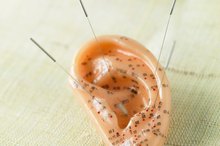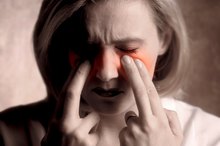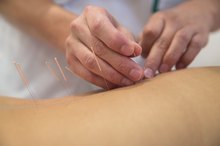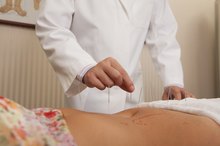What does fact checked mean?
At Healthfully, we strive to deliver objective content that is accurate and up-to-date. Our team periodically reviews articles in order to ensure content quality. The sources cited below consist of evidence from peer-reviewed journals, prominent medical organizations, academic associations, and government data.
- National Institute of Neurological Disorders and Stroke: Hemifacial Spasm
- PubMed Health: Bell's Palsy
- PubMed Health: Bell's Palsy
- "Chinese Acupuncture and Moxibustion"; Clinical Observation on Acupuncture Plus Laser Radiation for Treatment of Facial Spasm; Z.X. Lu; July 2006
- "Chinese Acupuncture and Moxibustion"; Clinical Observation on Acupuncture Plus Laser Radiation for Treatment of Facial Spasm; Z.X. Lu; July 2006
The information contained on this site is for informational purposes only, and should not be used as a substitute for the advice of a professional health care provider. Please check with the appropriate physician regarding health questions and concerns. Although we strive to deliver accurate and up-to-date information, no guarantee to that effect is made.
Acupuncture Treatment for a Hemifacial Spasm
Hemifacial spasm is a neuromuscular disorder characterized by frequent, involuntary contractions of muscles on one side of your face. The condition can continue until half of your face appears to "droop." Acupuncture may be beneficial for nervous system disorders. Points on the face and body are thought to stimulate proper nervous system function. Talk to your doctor about your condition, and discuss acupuncture as an adjunct to your regular treatment program.
If you are experiencing serious medical symptoms, seek emergency treatment immediately.
Hemifacial Spasm in Western Medicine
Hemifacial spasm occurs in both men and women, but typically affects middle-aged and elderly women. These spasms may originate from a compressed facial nerve, which interrupts nervous system signaling. Tumors, blood vessels and injuries to the face can affect the cranial nerves that innervate facial muscles. Beginning with intermittent eyelid twitching, hemifacial spasms can progress to involve the muscles on one side of the face, keeping them continuously contracted. One side of your face may appear to "droop," similar to Bell's palsy. Western medical treatments include surgery, botulinum toxin injections and medications to relax muscles. Prognosis is dependent on how you respond to treatments; you may have lasting effects for the rest of your life.
- Hemifacial spasm occurs in both men and women, but typically affects middle-aged and elderly women.
- Beginning with intermittent eyelid twitching, hemifacial spasms can progress to involve the muscles on one side of the face, keeping them continuously contracted.
Facial Spasm and Paralysis in Chinese Medicine
Acupressure Treatment for Eye Twitches
Learn More
Traditional Chinese medicine operates on the belief that the body is made up of energy, or qi, that travels most potently in lines called meridians that run along the body. The body's qi, as well as blood, can become stagnant or stuck, causing emptiness and excess in certain areas. Facial paralysis or spasm is thought to be mainly due to emptiness of the network vessels. External pathogens, like wind, heat or cold, can prey upon the vacuity, attacking your facial nerves and sinews in the face. Qi and blood are blocked, impeding the muscles' ability to relax and contract. Older patients are more at risk for neuromuscular disorders, and recover more slowly than younger patients. As you age, your qi and blood diminish, leaving you more vulnerable to deficiency or vacuity.
- Traditional Chinese medicine operates on the belief that the body is made up of energy, or qi, that travels most potently in lines called meridians that run along the body.
- The body's qi, as well as blood, can become stagnant or stuck, causing emptiness and excess in certain areas.
Points Used
Local points, or those in the affected area, are often used as main components in acupuncture's management of facial paralysis and twitching. Additionally, certain points can be joined together by one needle. Two points often joined are gallbladder 14 and yuyao, a point that doesn't lie on a meridian. Yuyao is found in the middle of your eyebrow, with gallbladder 14 residing 1 inch above it. These points help with deviation of the mouth and eye, drooping and twitching eyelids and facial pain. Stomach points 2, 4 and 6 are also recommended for mouth deviation, drooling, numbness in the face and contraction of facial muscles. Additionally, your practitioner may choose stomach point 36 and triple warmer 6 -- located on your leg and arm, respectively -- to help rebuild qi and blood.
- Local points, or those in the affected area, are often used as main components in acupuncture's management of facial paralysis and twitching.
- Two points often joined are gallbladder 14 and yuyao, a point that doesn't lie on a meridian.
Supporting Research
About Trigeminal Neuralgia & Ear Pain
Learn More
Though not guaranteed to treat or cure facial spasms, acupuncture has been shown effective in clinical studies. The "Chinese Acupuncture and Moxibustion" journal featured a study in July 2006 that examined the effects of acupuncture plus laser therapy on facial spasm 2. Out of the 390 patients, 200 received western medication and traditional treatment while 190 received acupuncture and laser therapy. Results showed that those in the latter group saw 93 percent effectiveness with only 6 percent relapse rate. The medication group only experienced 62 percent effectiveness, while almost 34 percent of patients saw recurrence of symptoms.
- Though not guaranteed to treat or cure facial spasms, acupuncture has been shown effective in clinical studies.
- The medication group only experienced 62 percent effectiveness, while almost 34 percent of patients saw recurrence of symptoms.
Related Articles
References
- "A Manual of Acupuncture"; P. Deadman, et al.; 2001
- "Chinese Acupuncture and Moxibustion"; Clinical Observation on Acupuncture Plus Laser Radiation for Treatment of Facial Spasm; Z.X. Lu; July 2006
- Langevin HM, Schnyer R, Macpherson H, et al. Manual and electrical needle stimulation in acupuncture research: pitfalls and challenges of heterogeneity. J Altern Complement Med. 2015;(21)3:113-28. doi:10.1089/acm.2014.0186
- Zhao L, Zhang FW, Li Y, et al. Adverse events associated with acupuncture: three multicentre randomized controlled trials of 1968 cases in China. Trials. 2011;(12):87. doi:10.1186/1745-6215-12-87
- Council of Colleges of Acupuncture and Oriental Medicine. Clean needle technique: CNT manual. 2015.
- Cho SH, Lee JS, Thabane L, Lee J. Acupuncture for obesity: a systematic review and meta-analysis. Int J Obes (Lond). 2009 33(2):183-96.
- Güçel F, Bahar B, Demirtas C, Mit S, Cevik C. Influence of acupuncture on leptin, ghrelin, insulin and cholecystokinin in obese women: a randomised, sham-controlled preliminary trial. Acupunct Med. 2012 Sep;30(3):203-7.
- Namazi N, Khodamoradi K, Larijani B, Ayati MH. Is laser acupuncture an effective complementary therapy for obesity management? A systematic review of clinical trials. Acupunct Med. 2017 Dec;35(6):452-459.
- Nourshahi M, Ahmadizad S, Nikbakht H, Heidarnia MA, Ernst E. The effects of triple therapy (acupuncture, diet and exercise) on body weight: a randomized, clinical trial. Int J Obes (Lond). 2009 May;33(5):583-7.
- Sui Y, Zhao HL, Wong VC, et al. A Systematic Review on Use of Chinese Medicine and Acupuncture for Treatment of Obesity. Obes Rev. 2012 May;13(5):409-30.
Writer Bio
Christy Callahan has been researching and writing in the integrative health care field for over five years, focusing on neuro-endocrinology. She has a Bachelor of Science degree in biology, earned credits toward a licensure in traditional Chinese medicine and is a certified Pilates and sport yoga instructor.

